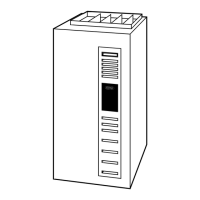The thermostat closes the R-to-G-and-Y circuits. The R-to-Y
circuit starts the outdoor unit, and the R-to-G and Y circuits start
the furnace blower motor BLWM on COOL speed.
The electronic air cleaner terminal EAC-1 is energized with 115
vac when the blower motor BLWM is operating.
When the thermostat is satisfied, the R-to-G-and-Y circuits are
opened. The outdoor unit will stop, and the furnace blower motor
BLWM will continue operating on the COOL speed for an
additional 90 seconds. Cut jumper J2 to reduce the cooling
off-delay to 5 seconds.
Step 3—Continuous Blower Mode
When the R-to-G circuit is closed by the thermostat, the blower
motor BLWM will operate on continuous-blower speed (same as
HEAT speed). Terminal EAC-1 is energized as long as the blower
motor BLWM is energized.
During a ″call for heat,″ the blower BLWM will stop during igniter
warm-up (17 seconds), ignition (7 seconds), and blower-ON delay
(66 or 45 seconds for 040 through 120 sizes or for 140 size),
allowing the furnace heat exchangers to heat up more quickly, then
restarts at the end of the blower-ON delay period at HEAT speed.
In heating, the furnace control CPU will continue running the
blower motor BLWM at HEAT speed after the selected blower-
OFF delay period is completed.
When the thermostat ″calls for cooling″, the blower motor BLWM
will operate at COOL speed. When the thermostat is satisfied, the
blower motor BLWM will operate an additional 90 seconds on
COOL speed before reverting back to HEAT speed. Jumper J2 can
be cut to reduce the cooling off-delay to 5 seconds. See Fig. 31.
When the R-to-G circuit is opened, the blower motor BLWM will
continue operating for an additional 5 seconds, if no other function
requires blower motor BLWM operation.
Step 4—Heat Pump Mode
When installed with a heat pump, the furnace control automatically
changes the timing sequence to avoid long blower off times during
demand defrost cycles. When the R-to-W-and-Y or R-to-W-and-
Y-and-G circuits are energized the furnace control CPU will
continue to turn on the blower motor BLWM at HEAT speed, and
begin a heating cycle. The blower motor BLWM will remain on
until the end of the prepurge period, then shut off for 24 seconds
then come back on at HEAT speed. When the W input signal
disappears, the furnace control begins a normal inducer post-purge
period and the blower switches to COOL speed after a 3 second
delay. If the R-to-W-and-Y-and-G signals disappear at the same
time, the blower motor BLWM will remain on for the selected
blower-OFF delay period. If the R-to-W-and-Y signals disappear,
leaving the G signal, the blower motor BLWM will continue
running the blower motor BLWM at HEAT speed after the
selected blower-OFF delay period is completed.
Control initiates a 90-sec blower only on period before starting
another heat pump cycle if there is a power interruption. Anytime
control senses false flame, control locks out of heating mode. This
reaction occurs because control ignores W input due to false flame
signal and, as a result, sees only Y input and goes into cooling
mode blower off delay. All other control functions remain in
standard format.
NOTE: EAC-1 terminal is energized whenever blower operates.
HUM terminal is only energized when gas valve is energized.
Step 5—Component Test
COMPONENT TEST
NOTE: The furnace control component test allows all compo-
nents to run for a short time; except the gas valve and humidifier
terminal HUM are not energized for safety reasons. The EAC-1
terminal is energized when the blower is energized. This feature
helps diagnose a system problem in case of a component failure.
The component test feature will not operate if any thermostat
signal is present ant the control and not until all time delays are
completed.
NOTE: Record the status code BEFORE opening the blower
access door and before shutting off power to the furnace. Opening
the blower access door will open the blower door switch and shut
A99118
Fig. 48—Inducer Housing Drain Cap
A99119
Fig. 49—Filling Condensate Trap
35
→
→
→

